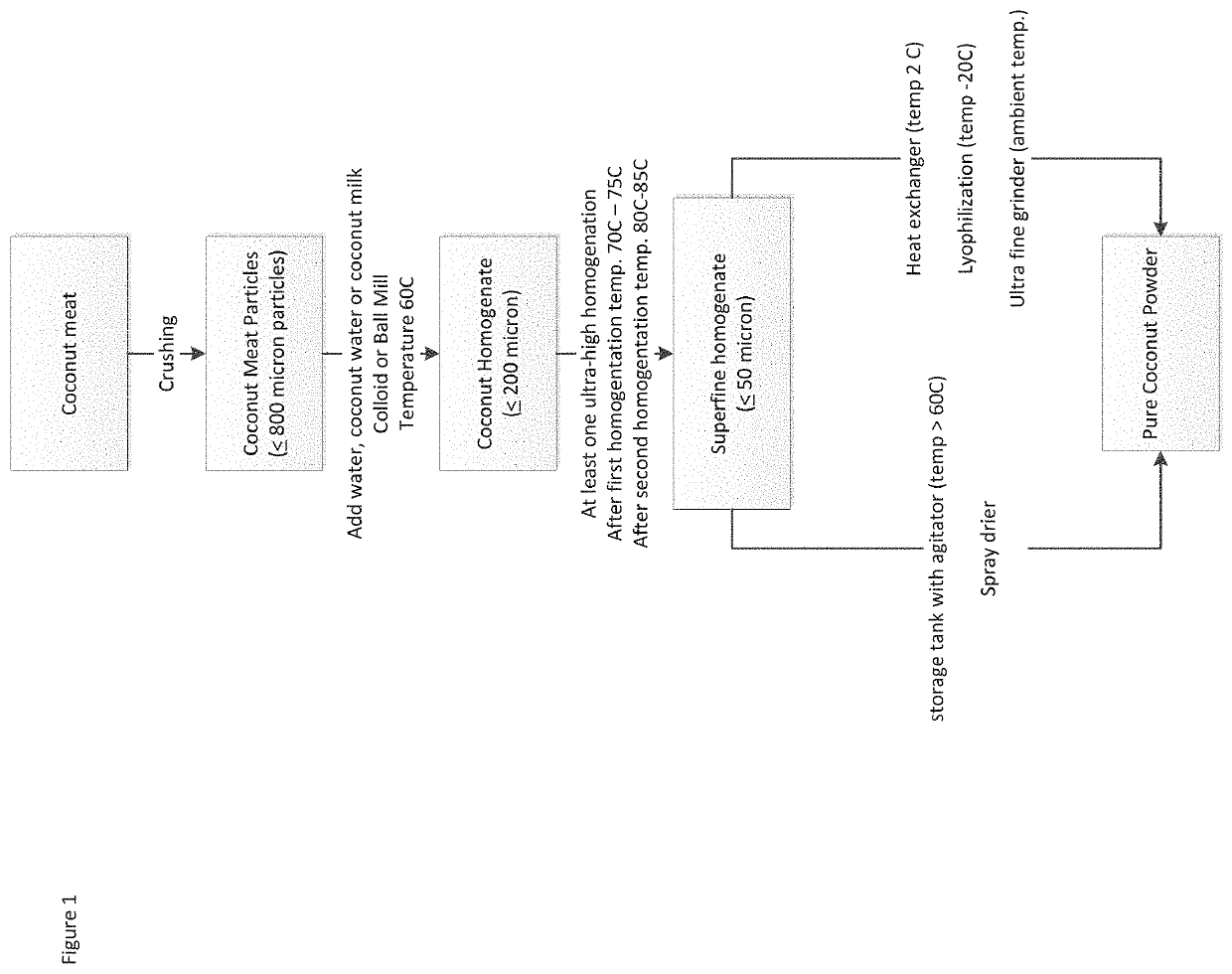Production method for pure coconut powder without the use of foreign additives
- Summary
- Abstract
- Description
- Claims
- Application Information
AI Technical Summary
Benefits of technology
Problems solved by technology
Method used
Image
Examples
example 1
ction of Pure Coconut Powder with Fresh Coconut Meat as Raw Material
[0042]1. Coconut homogenate: (1) 1000 kilograms of cleanly washed coconut meat without paring (fat 28%, dietary fiber 11%, water 54%, and protein 3%). (2) Add 1000 kilograms of water to the coconut meat, and after crushing it, circulate it in the colloid mill for 6 minutes. A ball mill could alternatively be used instead of a colloid mill, but colloid mill is preferred. At this stage, the temperature of the material is 60° C., and the average particle diameter of the coconut meat is 140-190 μm.[0043]2. Superfine homogenate: (1) 1900 kilograms of the above prepared coconut homogenate at 60° C. passes through the 100 MPa ultra-high pressure homogenization equipment, and the temperature of the material increases to 70° C. (2) The homogenate passes through another 120 MPa ultra-high pressure homogenization equipment, and the temperature of the material reaches 80° C.; the material that is obtained now is the superfine h...
example 2
ction of Pure Coconut Powder with Fresh Coconut and Coconut Water as Raw Materials
[0046]1. Coconut homogenate: (1) 1000 kilograms of cleanly washed coconut meat without paring (fat 28%, dietary fiber 11%, water 54%, protein 3%), which is crushed. (2)) Add 1500 kilograms of coconut water (fat 0.1%, protein 0.1%, total sugar content 2.6%, and ash content 0.5%) to the coconut meat and crush it again. (3) Circulate it in the colloid mill for 8 minutes. At this stage, the temperature of the material is 65° C., and the average particle diameter of the coconut meat is 160-190 μm.[0047]2. Superfine homogenate: (1) 2400 kilograms of the above prepared coconut homogenate at 65° C. passes through the 100 MPa ultra-high pressure homogenization equipment, and the temperature of the material increases to 72° C. (2) The homogenate passes through another 120 MPa ultra-high homogenization equipment, and the temperature of the material at this stage reaches 84° C.; the material that is now obtained i...
example 3
ction of Pure Coconut Powder with Desiccated Coconut and Coconut Milk as Raw Materials
[0049]1. Coconut homogenate: (1) 120 kilograms of commercial grade low-fat desiccated coconut (fat content 36%, dietary fiber 50%, water content 3%, protein content 4%, and average particle diameter ≤1 mm). The average particle diameter of desiccated coconut is reduced to ≤150 μm by means of an airflow pulverizer, from which 100 kilograms of low-fat desiccated coconut flour is obtained. (2) Feed it into an agitator tank, and then add 1000 kilograms of commercial grade coconut milk (fat content 30%, protein content 3%, and dry matter content 38%) and 600 kilograms of drinking water. Start the agitator tank, and maintain a rotation speed of 50 rpm and increase the temperature to 60° C.[0050]2. Superfine homogenate: (1) 1615 kilograms of the above prepared coconut homogenate at 60° C. passes through the 100 MPa ultra-high pressure homogenization equipment, and the temperature of the material increases...
PUM
 Login to View More
Login to View More Abstract
Description
Claims
Application Information
 Login to View More
Login to View More - R&D
- Intellectual Property
- Life Sciences
- Materials
- Tech Scout
- Unparalleled Data Quality
- Higher Quality Content
- 60% Fewer Hallucinations
Browse by: Latest US Patents, China's latest patents, Technical Efficacy Thesaurus, Application Domain, Technology Topic, Popular Technical Reports.
© 2025 PatSnap. All rights reserved.Legal|Privacy policy|Modern Slavery Act Transparency Statement|Sitemap|About US| Contact US: help@patsnap.com

